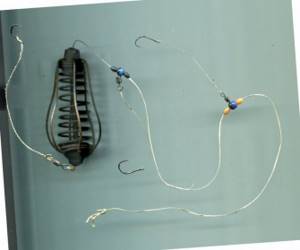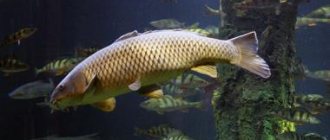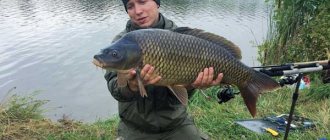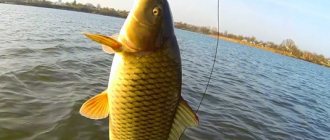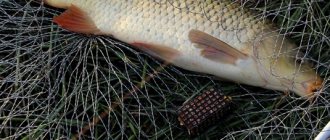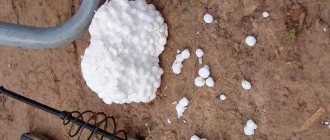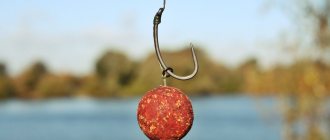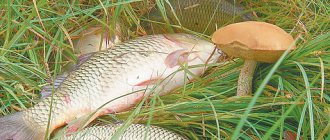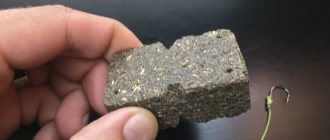Polystyrene foam as a bait for catching fish. Its properties
Of great interest are the properties of polystyrene foam, which make it an excellent bait for catching different types of fish.
First of all, it looks very similar to the food of such species as crucian carp, bream, roach, ide, etc. It does not have a smell that attracts fish, but the shape of small grains resembles the grain of corn, peas, lupine, pearl barley, etc. Currently, this material, valuable for fishermen, is found tinted to match the color of cereals.
When fishing with foam in the current, it is taken into account that the fish not only grabs the food lying on the bottom, but also tries to swallow the food that floats past. In this case, only the visual perception of an object floating by is triggered. The most important prerequisite that makes fishing with foam possible is the vision of aquatic inhabitants. They can distinguish objects only at a distance of 1 m. For this reason, without really seeing the artificial grain in the stream of water, they try to quickly swallow it.
The second very important property of polystyrene foam is buoyancy. He is almost weightless. If you put it on a hook, regardless of the strength of the current, it will begin to flicker in the water column and attract fish. The nozzle is above the bottom, and the fish willingly begins to peck at it.
The third, no less important property of polystyrene foam is the ability to retain odors. The next plus is compatibility with natural baits. The fifth, extremely important property is the ability of the granule to hold firmly on the hook. A ball pierced with a hook rotates freely, but does not fly off the hook. You can catch more than one fish with it.
And what is very important, foam bait is a free product. Fishing with such a bait does not require physical or time expenditure to prepare for it. It is worth noting that polystyrene foam is durable and lightweight.
Why does it bite?
When many people first become acquainted with the “foam” method of fishing, an obvious question arises in their heads about how it works and why the fish really bite on it. There are several opinions on this matter, but the main thing is that fish are attracted by the color of the bait.
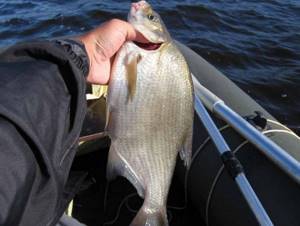
A bright white or light-colored ball of foam stands out in both clear and turbid water, and it is difficult for a sharp-eyed crucian carp to resist swimming up and trying the potential prey for its teeth.
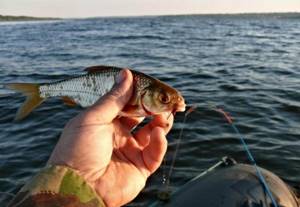
Some fishermen also believe that crucian carp accidentally swallow foam balls while digging at the bottom in search of food.
One way or another, the bite on foam plastic is often so intense that it makes anglers forget about the mechanism of its action, and numerous videos of fishing on foam plastic with a huge catch confirm this.

Advantages of polystyrene foam as bait
Many fishermen do not believe that it is possible to catch anything using polystyrene foam, let alone large catches. And all because they do not know the principle of its operation. They also do not know about the advantages that this artificial attachment has. Let's list the main ones:
- The material has a high degree of buoyancy, thanks to which it is always in the water column, regardless of the current speed.
- In their appearance, the balls resemble particles of food familiar to white fish (meaning tinted foam).
- They stay securely on the hook and remain in place even after a sharp cast.
- Polystyrene foam retains odor well, including in water. If you rub it with a fragrant substance, the aroma will last for quite a long time.
- The balls go well with animal and plant baits.
- Their cost is very small, one small bag costs a penny.
- The durability of the material allows you to stock up on it for at least a year in advance.
Fishing Features
You can put a foam bait on a hook alone, but it looks good together with whole peas, canned peas and dessert corn, and works great with a worm, maggot, and sometimes with bloodworms. Fishing with polystyrene foam is the same as with other types of baits. But there are still some advantages: the hook is clearly visible at long distances, floating slightly above the bottom surface.
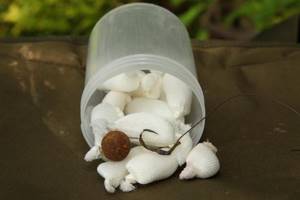
It is not difficult to place this attachment on the hook. First, you should put one ball on it, then attach a couple of maggots, followed by another ball. The tip of the hook should be visible so that during hooking it can freely slide further. The fishing features of foam fishing and the secrets of its effectiveness lie in the correct placement of the nozzle on the hook.
Peculiarities of crucian carp fishing - what is important to know
Styrofoam balls used as bait are often colored in a variety of colors. Those who wish to prepare them at home can use a permanent marker or fluorescent varnish to color them. Whole packages of already prepared, colored and flavored balls can be purchased at any fishing store. This is the same foam, only treated with flavoring additives and painted.
Important: Only the fisherman can decide which balls are best to catch. The main thing is to monitor the size of the nozzle.
The ball should not exceed the size of a corn grain. This is due to the small mouth of the crucian carp, which cannot swallow large objects. This is worth considering when choosing a hook. Large balls float above the bait table.
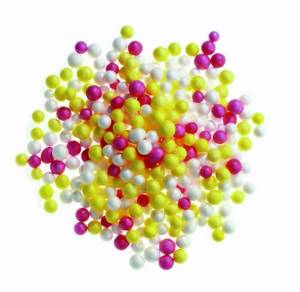
Material requirements
The properties of polystyrene foam determine its use as bait. Polyfoam retains the smell for a long time. The balls are held tightly on the hook. You can catch a large number of fish with one ball. Polystyrene foam is a cheap material; preparation for fishing will be inexpensive and will take place quickly. The ball can be placed on the hook along with peas, corn, bloodworms.
It is easy to put the foam on the hook. First, plant a piece of polystyrene foam, then 2 maggots or bloodworms, then another piece. The tip of the hook must be free so that when hooking it can freely slide into the mouth of the fish. The peculiarity of fishing with polystyrene foam is the correct installation of bait on the hook.
Buoyancy
The material floats perfectly on water and is lightweight. When put on a hook, no matter the current, it will float in the water and attract fish. Pieces of foam float near the bottom, and individuals begin to actively peck at them.
Visual appeal
Externally, the balls are similar to the food of fish of the carp family. Although the pieces of polystyrene foam have no smell, their shape resembles peas, corn, and pearl barley. When fishing on a river with a large current, take into account that the individual captures not only prey lying on the bottom, but also floating by. In this case, the fish’s visual perception of prey is triggered. The hook will be visible from afar; it will float slightly above the bottom surface.
Hooks for fishing on foam plastic
Bream, crucian carp, and carp react most quickly to small floating food, so the size of the foam balls should be small. That's why:
- The hook should be thin and light so that the bait does not sink.
- It must be of increased strength so that you can fish out not only small things.
- The hook should have a straight hook and a not very long shank - for better penetration deep into the fish’s lips.
Practice shows that catching bream on polystyrene foam is most effective with numbers 18-10.
How much foam do you need to hang on the hook?
Fishermen who have heard that crucian carp are caught using foam plastic also try to catch them, but in doing so they make one mistake. When hooking a foam ball, they don’t think about keeping it and the hook in the water column. As a result, the foam ball turns out to be too small and cannot lift the hook, or a heavy hook made of thick wire is used and the foam ball is not able to lift it. Therefore, the hook along with the foam sinks to the bottom and the likelihood that the fish will bite is practically zero. Therefore, before casting the tackle, you need to check whether the hook with foam plastic is sinking. It may happen that one large ball is enough, but sometimes you have to put 2 or 3 small balls in the form of a bead. To check, just throw the tackle into the water near the shore, where the depth is not great and the bottom is visible. If the hook with the ball rises and is placed in the water column, then everything is in order. If the hook does not come off the bottom, then you need to add foam or use another hook made of thin wire.
Fishing stores sell foam balls of any color and with any flavor. Because the foam is encased, it does not have the same characteristics as regular white foam. To use purchased foam, you will have to use hooks with a long shank and made of thin wire, since you will have to attach at least 2 or 3 balls. At the same time, balls of various sizes are sold, which allows you to choose balls for any occasion.
How does polystyrene foam work?
Foam balls are suitable for targeted fishing of most fish belonging to the carp family. For example, for catching crucian carp, bream, large bream, carp, carp, roach or rudd. Why is this fish interested in a completely inedible bait? There is no exact answer to this question, but there are several interesting opinions.
- The balls, painted in one color or another, look like grains of corn, peas and other crops. The fish suspects that this is food, but it does not have time to check its assumption. Appetite, greed and competition force her to grab the bait at random. By the way, flavorings help to deceive her almost completely.
- The floating ball rises above the feeder to the height of the leash (usually short) and prevents the fish from sucking up the food. She has to constantly push him away with her nose. This happens until the sharp sting sticking out of the foam catches on the lip. Trying to free himself from it, the victim self-cuts himself.
- During the current, light balls play in the water no worse than a jig in the hands of an experienced fisherman. They move enticingly, provoking the fish to bite.
Colored and scented foam balls
Now on sale you can find polystyrene foam in a variety of sizes and colors, with and without a smell, there is even one covered with a special soluble shell (for example, pea). On the issue of coloring, fishermen's opinions were divided. Some believe that there is no need for it, others insist that ordinary white foam plastic is not to the fish’s taste; the ball must definitely resemble something edible. Fortunately, there are no problems with colored baits today.
If earlier you had to paint the foam yourself, using special aerosols and water-repellent felt-tip pens, today you just need to look at the first fishing store you come across and buy a bag of balls of the appropriate color.
Disputes continue over the advisability of aromatizing this bait. Proponents of fishing with odorous material either buy already scented balls, or take regular ones and saturate them with the desired scent themselves. This can be done in two ways: soak in a solution with the addition of garlic, star anise, dill, hemp seeds, vanilla and other natural flavors, or spray with a special spray directly while fishing.
How to catch roach using polystyrene foam
Firstly, its balls are visually similar to the food that fish eat (barley grain, corn, lumps of dough). For greater catchability, they are tinted in the colors of cereals and impregnated with flavors (and the foam retains odors well). So roaches like the aroma of vanilla, caramel and rum (small individuals), chocolate and almonds - large ones. An important property of this bait is its buoyancy: it floats in the water column, attracting the attention of the fish. This is especially important when the roach is not at the bottom. Foam can be combined with other types of bait. If you pierce the ball all the way through, it sticks well to the hook, so after catching one fish you don’t have to change it (however, it’s still worth stocking up on a few balls). Its advantages include cost-effectiveness (does not require material costs, does not require time to prepare, does not take up much space in a backpack, does not spoil for a long time).
The roach prefers a bait moving near the bottom to one lying on it, and during the current in muddy water it does not have enough time to clearly see the bait - this is the basis for catching roach with a feeder on foam plastic with or without the addition of regular bait.
How to place foam on a hook
Not every fisherman manages to correctly attach the foam to the hook, and the intensity of the bite often depends on this. The bait should be secured so that the hook is completely hidden from the fish, and the tip should instantly hook it even at the slightest touch. That is why when preparing equipment you should adhere to the principle of harmony, using from 1 to 3 balls. To do this, you should definitely pre-train a few days before going out onto the pond.
Find out also how to prepare pearl barley for fishing in a thermos.
Also, when setting balls, the buoyancy of the tackle must be taken into account. When diving, the equipped hook should stay well in the water column. If the tackle lies on the bottom, or vice versa, pulls the feeder up, you need to adjust its buoyancy. Ideally, this should be done in a separate container, before the main casting of the bait.
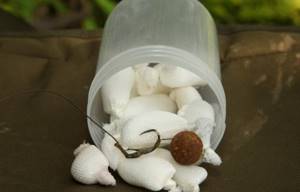
Carp on polystyrene foam and makushatnik
To catch carp using polystyrene foam, it is better to use a bait or feeder method. Equipment with foam plastic for carp looks like this:
- Rod. An ordinary durable feeder or a special carp feeder.
- Working line.
- Makushatnik or method feeder.
- A short leash, five to seven centimeters.
- Carp hook with foam, giving positive buoyancy.
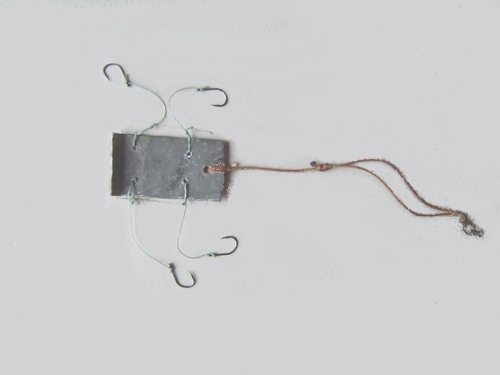
The equipment for carp differs fundamentally from the equipment for other types of fish in the presence of a makushatnik - a lead plate with a piece of makukha (sunflower cake) attached to it. The carp, sucking the cake, constantly encounters the foam bait and, in the end, swallowing it, feeds itself thanks to the heavy lead plate.
The method feeder for foam fishing is filled with bait containing dusty components. The principle of its operation is similar to the work of the makushatnik.
To better seduce the owner of our ponds, bait balls can be painted corn yellow or red.
Bream and foam
There is no single point of view on what attracts fish to foam balls (expanded polystyrene). Fishermen cite the following reasons:
- External resemblance to plant grains. The effect is enhanced by tinting. Practical experience suggests that the most attractive colors for bream are white and yellow . And the sizes should not differ much from the grains washed out of the feeder.
- Movement in the water column. Due to its uniquely low density, a particle of polystyrene foam constantly strives towards the surface. The leash and hook prevent floating. The current interferes with this process, and the struggle goes on with varying degrees of success. The ball constantly moves and attracts the attention of the fish. In any flock, an individual strives to be the first to grab prey. A noticeable, bright granule falls into the field of view faster than others and becomes the target of attack.
It is believed that polystyrene balls are perceived by fish as garbage. To get to the contents, the bream filters all the water near the feeder through its gills and accidentally swallows the bait.
Ease of use of foam bait
You can joke that polystyrene foam was created for fishermen.
Its positive properties:
- Cheap and accessible . For fishing, you can buy a bunch of bright bags with single-color granules with a certain aroma. It’s easier to put a piece of construction foam in your pocket. Its advantage is that the monolith is formed from granules of different sizes. Note! The size of the balls is no less important than their color and aroma.
- Easy to string on the hook and secure grip. This is an important factor when fishing using long casts. Does not require replacement after numerous impacts with water.
- High adsorbing capacity. Expanded polystyrene fragments actively absorb and are able to retain the aroma of impregnation in an aqueous environment for a long time. At home, cinnamon, vanilla sugar, and garlic will add flavor to the balls.
Why do crucian carp bite on foam balls?
There are some features of fishing with bait such as foam balls. But before you talk about this, you need to figure out why this fish pays attention to such a bait.
Some are of the opinion that crucian carp is attracted by originality and brightness. This fish has good eyesight, which allows it to see prey at a distance of up to one meter. Well, this fish can easily see a white or even colored foam ball on a rocky, sandy or even muddy bottom. Crucian carp are curious, therefore, having noticed something new, they immediately, without hesitation, strive to taste it.
Others are sure that the fish swallows such balls fleetingly while eating complementary food on the bottom. Especially if you fish in a river with a fast current. The fish has no time to think; it attacks its prey, not allowing it to swim past. According to the third hypothesis, fish get rid of debris through their gills. Including trying to get rid of the foam ball. It prevents him from getting to food. But in the end she hooks herself.
Important: Those who aromatize foam believe that it is the smell that attracts fish. We should not exclude the fact that the white ball looks like a piece of dough.
There are quite a lot of opinions about why crucian carp bite on foam balls. But one thing is clear - this bait turns out to be one of the best.
Why fish are caught on foam plastic
There are several opinions as to why fish are caught using foam baits:
- out of curiosity for a bright and noticeable bait;
- accidentally, mistaking it for garbage;
- purposefully, perceiving the foam as food.
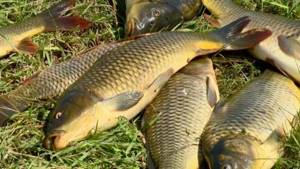
Most fishermen believe that the reason for biting on foam balls is their visibility on any bottom: muddy, rocky, sandy, and clay. Out of curiosity, the fish, having discovered a white or colored ball, but bright and unfamiliar to it, decides to taste it.
Many fishermen believe that the foam is perceived by the fish as debris, preventing it from reaching food from the feeder. In this case, the larger fish swallows the foam ball, intending to pass it through the gills like any other garbage. She does not realize that there is a hook in the ball, and due to the weight of the feeder, self-hooking follows.
The average fish, which may not fit the entire foam ball in its mouth, will often catch the hook with the edge of its lip. This indicates that she does not perceive the foam as food, and she is not careful.
A very small fish tries to push away the foam ball with its head, making increasingly stronger movements. As a result, she often gets caught on the hook on her scalp.
Some fishermen are sure that fish are attracted to the foam plastic by the smell and appearance, similar to a piece of dough, corn, barley, or a pea. They treat the balls with various flavors and paint them in appropriate colors to attract fish to the bait.
Read more
Wobblers from Salmo
Tackle for catching crucian carp using polystyrene foam
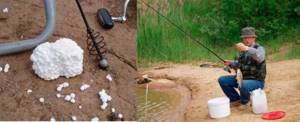
To catch crucian carp using foam plastic, you will need bottom tackle with a spring-shaped feeder. Although many anglers believe that the “nipple” may be the most effective. The “crucian carp killer” tackle consists of several “spring” type feeders, located one after the other, so this option will be considered.
Before casting the tackle, the spring is stuffed with bait, and foam balls are placed on the hooks. As a result, it turns out that the pieces will be in the water column above the feeder due to positive buoyancy. The crucian carp will definitely become interested in the contents of the feeder and begin to eat its contents.
At the same time, when the crucian carp is feeding, the hooks with foam plastic are very close, since the length of the leashes can be only 5 cm. Having occupied the feeder, the crucian carp also swallows foam balls. As a result, the fish ends up on the hook. It self-cuts under the influence of the weight of the feeder. There are several versions among fishermen about the reason that crucian carp swallows foam balls:
- The crucian carp gets carried away with eating the contents of the feeder and at the same time swallows a foam ball. It's hard to say what the white ball reminds him of. It is quite possible that he sees a balloon in it and decides to swallow it in order to replenish his air reserves. There are also foam balls covered with a shell of different colors and smells. If the ball is similar to a pea or a grain of corn, then everything is clear: the crucian carp will not refuse such a delicacy. Having swallowed such a ball, the crucian carp immediately ends up on the fisherman’s hook.
- There is another opinion, which is based on the fact that crucian carp is still able to determine how edible the bait is. If everything is clear with multi-colored balls, since they can look like ripe peas, green peas, or corn and can smell the same, then with ordinary foam balls, on the contrary, nothing is clear. Most likely, the crucian carp has determined that there is some kind of garbage flying around its feeding area that needs to be removed. In addition, this garbage interferes with normal feeding and the crucian carp takes this ball into its mouth and tries to move it away from this place. So he ends up on the hook.
Equipment
Equipment for catching crucian carp using polystyrene foam is sold in any fishing store. There are many varieties, including the “crucian carp killer” rig. Other accessories, such as “pacifiers,” may be suitable for this purpose, but this is not for sale, since you can easily make it yourself. If you don’t want to spend precious time making equipment, then it’s better to buy, especially if funds allow. There can be 2-3 hooks near each feeder spring, although many fishermen attach up to 6 hooks. If they are secured correctly, on short leashes, they will not get tangled.
For the equipment to work correctly, it is necessary to properly secure the leashes with hooks. Usually they are attached to both sides of the feeder. On a purchased feeder, the hooks may not be tied as needed for fishing with foam, so they will have to be moved to another place. The most important thing is that the length of the leashes does not exceed 5 centimeters. As practice shows, this is the optimal length of leashes for such gear.
Rod
Since this is a bottom tackle, it must be equipped with any fishing rod, either a spinning rod or a feeder rod. Naturally, a feeder rod will cost much more. Many fishermen still use old Soviet spinning rods with inertial reels. Unfortunately, they are not suitable for catching crucian carp, since you will have to frequently re-throw the tackle, and it is difficult to determine bites on them. The fact is that bite detection is carried out by the movement of the rod tip. In this case, the softer the rod tip, the more sensitive the tackle, and old spinning rods are very rough and rigid.
Coil
For such fishing conditions, it is better to opt for a spinning reel. There are no special requirements for the reel, but it must be powerful, since you will have to throw significant weight over a long distance. The reel should fit at least 50 meters of fishing line, 0.3 mm thick. Spool size 2500-3000. This will be quite enough.
fishing line
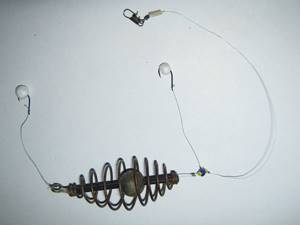
Despite the fact that mostly you come across individuals that weigh no more than 150-200 grams, fishing line thinner than 0.25 mm cannot be used. A feeder filled with bait can weigh up to 100 grams and when casting, a thinner line simply won’t hold up.
Hooks must be attached to elastic leashes. It is better to use a thin white cord for this, although fishing line about 0.15 mm thick will do.
Fishing technique
Before you start throwing foam balls, you need to feed the future location. After this, food is poured into the feeder, foam is put on the hook and the tackle is thrown into the water. After this, it is important to be on guard all the time, because the self-hooked fish will begin to escape, and you need to be prepared for this.
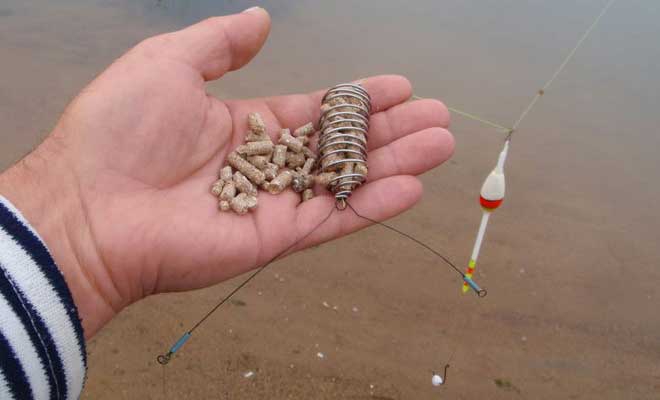
At this point, you need to keep the line taut until the fish is on the shore. You can’t give in any slack, because the crucian carp can easily get away. Experienced fishermen recommend pulling the trophy with a rod, making upward movements, and during the period of lowering, simply reeling in the line with a reel. If fishing is carried out close to the reeds, you must ensure that the fish does not go into the thickets, otherwise there will be neither a trophy nor a fishing line. You should keep your catch in clean water until it is in the net. Small specimens can be easily pulled out just like that, but large ones cannot be managed without a landing net. Many fishermen said that at the very last moment, when they were about to rejoice at the trophy, it suddenly broke down and left.
Of course, catching crucian carp with foam plastic may seem unusual and unusual to some, but once you try it, it will be difficult to give up. If you choose your tackle and bait wisely, a positive result will not be long in coming.
Secrets of a good catch when fishing with foam plastic
Since crucian carp has a very developed charm, he is interested in unusual smells. And what is noteworthy is that he is suspicious of the shipped gear. This means that if he feels that the weight of his prey is too heavy, he will immediately spit it out and swim away from that place.
- The crucian carp has at least five different bites. He can bite sharply, and sometimes he tugs at the bait for several minutes and eventually swims away.
- It has been noticed that crucian carp are often quite capricious. For example, this gourmet today only bites on a worm, and tomorrow on anything, but does not pay attention to the worm at all.
- In some reservoirs, crucian carp may not bite at all until lunchtime.
In summer, catching this fish is not only interesting, but also effective. It is during this period of the year that he is more active. In summer you can use more fishing options.
The main thing is to be well prepared for catching crucian carp. It is better to take several types of foam balls with different flavors.
In general, fishing for crucian carp is quite exciting. Even though you don't need to spend a lot of money for this, you should be well prepared. You need to try all the options for feeding and gear from your own experience.
When is the best time to fish with foam?
In the current, with the greatest success, foam for fishing is used as bait in the spring and early summer, since it is at this time of year: This bait is in great demand among fish from the beginning of spring to the beginning of summer
- the water has a temperature that helps the fish catch the smell of bait from afar;
- the fish eats up after winter, trying to gain strength before and after spawning, and responds well to bait.
Starting from mid-summer, fish respond less well to bait, so using polystyrene foam for fishing is not very effective.
In still water, the best results when fishing with foam come in the summer, when the fish switches from animal food to plant food.
The bite is greatly influenced by weather conditions. With the onset of spring, the warmer and sunnier it is, the better the fish bite. But in the summer, when the heat begins, it is better to catch fish with foam in cloudy weather, with light rain, as well as at dawn or before sunset.
Tackle
Equipment for fishing with foam plastic should also have some features. Coarse tackle does not combine well with such a light bait as a foam ball, so it would be better to use thin fishing line or braid.
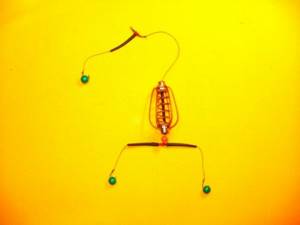
It is better to choose a hook in the range from “ten” to “sixteenth”. It is recommended to make eyeliner at least 7 cm, but the optimal value is 3.5 centimeters.
